
|   |

|   |
The dance of soul, the soul of dance - within - Shveta Arora e-mail: shwetananoop@gmail.com Pics: Anoop Arora October 8, 2013 If you wish to find a pearl, you have to dive deep into the depths of the ocean. Aditi must have got a bounty of pearls, because that is how deep she went within the ocean of emotions. There must be a cache of thoughts in her petite frame. Aditi Mangaldas’ dance company, The Drishtikon Dance Foundation, in association with ICCR, Impulse and Teamwork Productions, presented ‘Within’ on the 13th, 14th and 15th of September at the Kamani Auditorium in New Delhi. Aditi Mangaldas is an acclaimed Kathak and contemporary dancer. She is the disciple of Kumudini Lakhia and Pt Birju Maharaj. The Drishtikon Dance Company has dancers trained under her. She has performed extensively in the country and abroad and has many national and international awards to her credit. 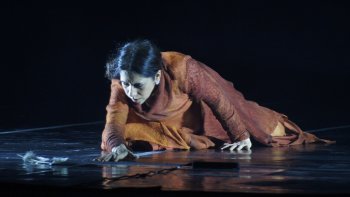
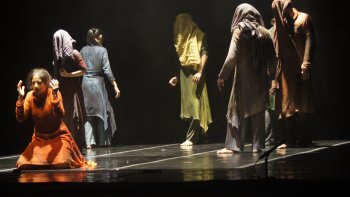
The performance began punctually with no frills, no lamp lighting, no introductions and no chief guest. The first part of the production, ‘Knotted’ was scheduled for forty minutes. The performance began with the beating of the drums and the dancers running across the stage. They were falling and running as if to save their lives. Then the actions of Aditi symbolized the flames of fire. Further, she enacted the three principles of speak no evil, hear no evil, see no evil. This was followed by nritta by the group of dancers. Suddenly there is thunder and a feather drops. Aditi wriggles on the floor to catch it, but it moves away, eluding her. The dancers then lay down, falling and slithering, piling on top of each other. Next, Aditi sat with her back to the audience, knotted up in a foetal position. She tries to open her limbs, and closes them again many times. This was followed by some violence and fight, turmoil and lastly, the act of muffling the voice. The music composition of the piece was by Ish Sehrawat and Diffused Beats (Sound Reasons), which was very effective in showing the dark side of the theme. The recording musicians were Mohit Gangani on tabla, Ashish Gangani on pakhawaj and Saskia Rao De Haas on the cello. Costume design was by Kimie Nakano, costume realization by Sandhya Raman and script by Vani Subramanian. Stage design was by Manish Kansara and light design by Fabiana Piccioli, technical coordination by Sander Loonen and research by Ragini Pasricha and Aditi Mangaldas. The stage design of the panels in the background, according to Aditi, “was more about our inner landscape. The scratches or ruptures on our inside and outside, the ruptures through which both hate and love can flow out, depending upon what we let out.” The colour and the texture of the panels signified the barren and the brutal texture of our insides without any foliage or flowers of gentler emotions. The dancers represented the thoughts and emotions that burst on the terrain of our minds. The colours of the costumes - burnt sienna and dark green - probably showed the emotions that charge and ignite us and those that are dark and brutal. These emotions run awry, flame and charge. The feather, according to Aditi, is the “end of freedom. A small change in one place can create havoc in another. An innocent thing like a feather can create devastation if brutality rules our within.” Perhaps the feather represented the fragility and unimportance of our pursuits. Aditi’s actions showed how elusive these are. We crave for them while these material things elude us. The slithering bodies, according to Aditi, are “our inner emotions in constant half embrace - the brutal and the human. Do we honestly see these interplays?” The dancers wriggled and slithered on the floor, finally piling on top of each other in a heap. The mind is the battlefield for these emotions and the tug of war perpetually goes on in each of us. The following actions by Aditi of knotting and opening her body showed how knotted our thoughts become, trying repeatedly to break free from each other, but then again getting bogged down in the quagmire. Aditi was right in saying that we may not like what we may see, since its import of the turmoil and violence within us is not a pleasant theme to be portrayed. 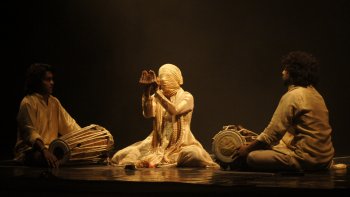
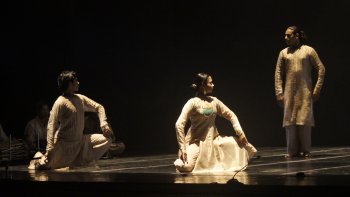
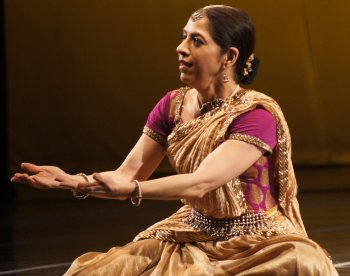
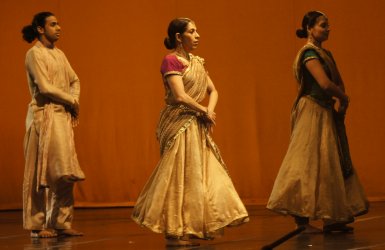
The second part of the performance, ‘Unwrapped’ began with the pakhawaj players on stage with their backs to the audience. The dancers wore cream coloured costumes with their faces wrapped with their dupattas. The group performed a classical nritta piece. Then they mimicked like a faceless creature looking into the mirror. Aditi then recited lines from poetry by Kashmiri poet Lal Ded, translated by Ranjit Hoskote. “Wrapped up in yourself you hid from me all day, I looked for you.” Amazing nritta to the clanking sound of manjiras was followed by padhant. Then it was total stillness. Next, it was footwork by the dancers as if conversing with each other in thaap. Aditi did interpretative dance to a composition by Sant Kabirdas – “Kehat kabir suno bhai sadhu, nis din sai hamara, is ghat antar bagh bagiche, isme seenchan haara. Is ghat antar anhad garje, isme uthat phuhara.” The background started changing to a radiant yellow. The nritya was expressive and Aditi’s chakkars had awe-inspiring energy and pace. “Wrapped up in Yourself, You hid from me and when I found You hiding inside me, I ran wild, playing now me, now You,” Aditi recited. The entire group joined her for nritya on ‘Aajra din dooba’ by Pandit Kumar Gandharva and ‘Yaar ko hamne jabaja dekha, kahin zahir kahin chhupa dekha’ by Hazrat Shah Niaz. The entire group exhibited breathtaking abhinaya and classical nritta in the two compositions. The speed, energy and footwork were flawless. The music composition for the piece was by Mahesh Vinayakram. The costumes were designed by Aditi herself. Tabla by Mohit Gangani and pakhawaj by Ashish Gangani as always was mind blowing. The lights complimented the performance. Vocals and harmonium by Faraz Ahmad was very melodious. The costumes and dance according to my interpretation showed humanity as becoming a faceless entity devoid of all emotions and sensibilities. All that defined it is hate. “To understand yourself, you must create a mirror that reflects accurately what you are – only in the understanding of what is, is there freedom from what is,” said J Krishnamurti. But what will the mirror reflect when the object is faceless? The final section of the performance is about attaining enlightenment. It is only when you journey within yourself and after the covers of other emotions are removed that the eternal truth surfaces. “Aajra din dooba, ab to jag re.” It is only when the cycle of life reaches its dusk that man awakens to the truth. It is when the truth surfaces and unwraps these complex emotions that you come face to face with the Almighty, who is referred to as the ‘Yaar’ or lover. We are a part of Him. If He is the sun, we are the lamps. All that He requires of us is to remember Him while fulfilling our worldly duties. But we allow the ‘maya’ to take over and wrap ourselves in negative emotions like hate and brutality. It is only when we unwrap ourselves of these emotions that we find Him within ourselves and the boundaries between ‘you’ and ‘me’ collapse and become ‘You’ only. What follows is the ecstasy of the union. “Yaar ko hamne jabaja dekha, kahin zahir kahin chhupa dekha.” It was indeed a very complex theme to portray in dance but Aditi and her group of dancers did a mesmerizing job. It was flawless and left the audience spellbound. “I found myself inspired by the emptiness and eternal space of the siddha sculpture.” Aditi referred to the siddha sculpture of Lord Mahavir, standing with his hands on his sides. The entire sculpture creates a vision of cosmic space and an out of body experience. On being asked whether she subscribed to some particular belief, she simply said, “Humanity.” The dancers in the group were Dheerendra Tiwari, Piyush Chauhan, Amit Khinchi, Preeti Sharma, Karan Gangani, Shubhi Johari and Minhaz Khan, and of course, Aditi herself. About the production and what triggered it, Aditi says, “The whole process began a few months back, when we were pondering over the various levels of dialogue between male and female. We were examining the dialogue between Shiva-Shakti. But last year, some horrific events of brutalization of females, which we were reading about in the news, were a trigger to look beyond the equation between male and female, to comprehend what is happening to human beings in general. So it’s been a change of perspective to an interplay between good and bad, hate and love, male and female, brutality and humanity. If there are changes in a person at the age of 15 or 16 that bring out the brutal side in him, it has to be analyzed. Hence, we began with mythological stories of Shiva-Shakti, Brahma desiring his daughter, the story of Amba, Ambika and Ambalika, and trying to associate them with present social events. But finally, we removed that layer altogether and we concentrated on the socio-economic causes of behaviour that is unthinkable, be it from man to man, woman to woman or man to woman. We finally removed the gender bias. For a dance piece, we need a core to conceptualize, so the core of the production is an exploration of our inner self. Something like a mirror that shows ‘this is you.’ Sometimes we do not accept the image that we see. We do not want to accept reality. When we recognize reality, we come closer to finding the sky within us. But for that, coming to terms with the reality is essential. I think Salman Rushdie put it very pertinently, when he said, ‘Classically, we have defined ourselves by the things we love. By the place which is our home, by our family, by our friends. But in this age we’re asked to define ourselves by hate. That what defines you is what pisses you off. And if nothing pisses you off, who are you?’ The production is actually disturbing and not always very pleasant to watch.” View Slide show  Photos: Dinesh Khanna Shveta Arora is a blogger based in Delhi. She writes about cultural events in the capital. |